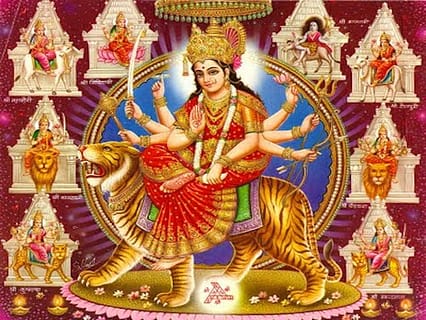 Navratra is a Sanskrit word formed by the union of two words ‘Nav’ – meaning nine and ‘ratra’ – meaning night. Here number 9 is of great importance. It is magical to see that when we enumerate the table of number nine, 9 gets repeated again and again…viz.
Navratra is a Sanskrit word formed by the union of two words ‘Nav’ – meaning nine and ‘ratra’ – meaning night. Here number 9 is of great importance. It is magical to see that when we enumerate the table of number nine, 9 gets repeated again and again…viz.
9, 18(1+8=9), 27(2+7=9), 36(3+6=9), 45(4+5=9), 54(5+4=9), 63(6+3=9), 72(7+2=9), 81(8+1=9) and 90(9+0=90).
Similarly 1 year has approximately 360 days which again adds up to 90 and finally 9. If we divide 360 by 9 we get 40 which is the number of navratras in one year. Number 40 is again of significance as 40 days forms 1 “Mandala” and it is customary to chant any mantra for 40 days to have an effect on the sadhak. If out of the number 40 “0” is separated the number 4 that is left denotes the 4 major Navratras celebrated in India.
They are—
1.Chaitra Navratras.
2. Ashad Navratras.
3. Ashwin Navratras.
4. Paush/Magh Navratras.
These are symbolic of the four virtues—“Dharma, Arth, Kama and Moksh.” If Dharma is amalgamated in Arth i.e. if we use money for righteous purposes and Kama in Moksh i.e. we desire only the divine then we are left with only two basic virtues and they are symbolized by the two most popular Navratras namely Vasant Navratra and Sharad Navratra. Vasant Navratra is celebrated from the first to the ninth day of shukla paksha (the waxing moon) in Chaitra month of the Indian calendar. Sharad Navratra is celebrated from the first day to the ninth day of the waxing moon in Ashwin month of the Indian calendar .The other two Navratras are called as “Gupt Navratras” falling in the months of Ashad and Paush/Magh of Indian calendar. Beginning of the summer and autumn are two very important junctions of climatic and solar influence. These two periods are taken as sacred opportunities for the worship of the divine mother.
Although there are six seasons in one year, yet only two main seasons are clearly demarcated — Winters and Summers. According to Indian calendar, Winter is experienced from Ashwin to Sharad Ritu and Summer from Chaitra to Vasant Ritu. This forms a pair of opposites. One denotes (Agni) wheat which is harvested in the month of Chaitra and the other (cool/Som) rice which is harvested in the month of Ashwin. Thus mother nature showers her blessings on us by providing a pair of wholesome and life –preserving gift twice a year which is a time for thanks giving and celebration. Life itself is always in a flux of opposites of “SUKH” and “DUKH.” Hence we celebrate the “Two” (pair) Navrataras.
1. Navgauri or Parbrahm Sri Ram’s Navratra.
2. Nav Durga Navratra.
Now the curiosity ‘why is the Devi pooja done for nine days?’
1. Because Maa Durga has nine forms.
2. As we have seen above one Navratra is 40th part of one year.
3. Energy (Shakti) is manifest in three forms in all living beings i.e. Satva, Rajas and Tamas and thrice of this is again 9.
The interplay of these three “gunas as they are called forms the basic nature (Prakriti) of an individual. We aspire and achieve according to our own specific nature.
Therefore the sacred nine days twice a year are an excellent opportunity to tune our Prakriti with the Divine and accomplish the impossible (according to us). Our rishis professed the importance of the “Transition time or the Sandhi kaal” when the two opposite forms of energies merge. Navrataras are the Sandhi of two seasons a time for contemplation and preparation for the forthcoming journey in “TIME”…
May Maa Durga and Sri Ram protect us and bless us all in our journey……
Friends, wishing you all powerful and joyous Navratras!
या देवी सर्वभूतेषु शक्ति रूपेण संस्थिता
नमस्तस्यै नमस्तस्यै नमस्तस्यै नमो नमः
Ya Devi Sarv Bhuteshu Shakti Roopen Sansthitha
Namastasye Namastasye Namastasye Namo Namah!


